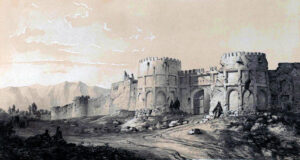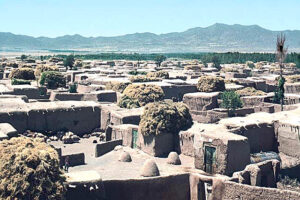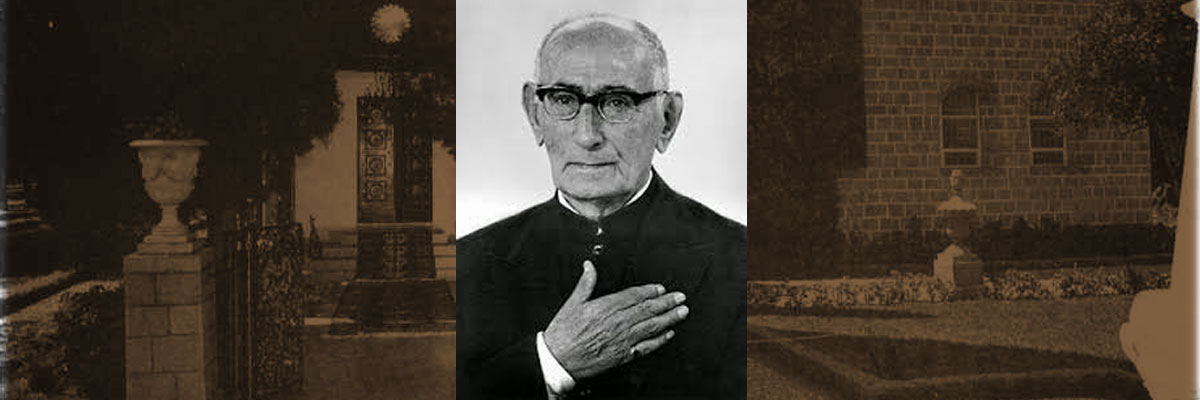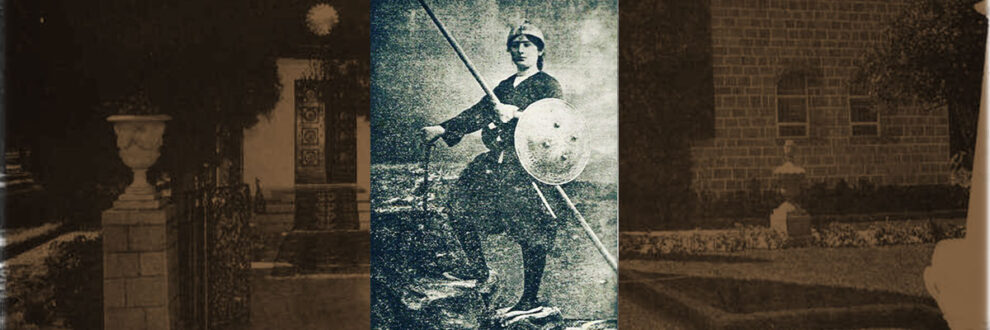 Zeynab – the Legendary Maiden of Zanján, entitled Rustam-‘Ali
Zeynab – the Legendary Maiden of Zanján, entitled Rustam-‘Ali
Born: Approximately 1834
Death: Approximately July 1850
Place of Birth: Zanján, Iran
Location of Death: Fort of ‘Alí-Mardán Khán, Zanján, Iran
Burial Location: No cemetery details (vicinity of Zanján, Iran)
One of the challenges of researchers is finding accurate sources of the Bábi-Bahá’í events during the early period of its survival. Our bulk of historical accounts are based on verbal recollections from early believers as well as written memories. These memories rarely account for precise information about the individuals who played an important role in countless incidents and dates and locations are omitted. Also there is no reference as to the source of their information. Nabil who started to write his colossal narrative in 1850, was an eyewitness to numerous historical events. His sources, prior to that date, have been mainly oral accounts from elderly eyewitnesses or their children who survived various upheavals. He is perhaps the first historian who gave a reference to his sources who are Mírzá Aḥmad-i-Qazvíní, the Báb’s amanuensis; Siyyid Ismá’íl-i-Dhabíh; Shaykh Ḥasan-i-Zunúzí; Shaykh Abú-Turáb-i-Qazvíní; and, last but not least, Mírzá Músá, Áqáy-i-Kalím, brother of Bahá’u’lláh.
The masterly translation and editing of the Beloved Guardian to Nabil’s Narrative inaugurates a new era of history writing in the Bahá’í World. Hundreds of footnotes, sometimes in their original languages, with their accurate sources, mostly from non-Persian military men or orientalists who were residing in Persia, ornate the pages of the Dawn-Breakers, Nabil’s Narrative. This exertion gives a unique academic value to the history of the Faith, which is now followed up by practically all the authors throughout the Bahá’í World.
There is also a vast historical record written by the nineteenth century Qajár court historian Sipihr, entitled Násikhu’t-Taváríkh (The Abrogator of Histories). It is obvious that Sipihr’s main or perhaps the only source of information on the Bábi battles were official reports and military dispatches. Although he does not give any reference to his sources, he gives dates of troop movements, casualty lists and details of the major assaults. There are conflicting dates between the above volume and the Bahá’í sources as well as prejudicial accounts which discredit the purpose of the Bahá’í Cause.
The diplomatic dispatches in various archives in Europe show that the British and French Attachés regularly informed their respective governments about the Persian events during the Báb’s ministry. Therefore, it is not surprising to find the following newspaper clipping from Galveston Gazette on January 24, 1851 that “Paris papers contain accounts from Teheran, Persia, giving an account of the execution of the chief of the sect of the Bábis at that capital. One of the dogmas of this sect is the social equality of man and woman, and its followers having taken up arms in defense of their creed, were aided by a regiment of about one thousand women, who are represented to have used their muskets with very considerable effect in the engagements which took place with the royal troops, although ultimately overpowered.”
 The legend of heroine of the battle of Zanján is unique in religious history! It rivals the bravery of Joan of Arc, in the Hundred Years’ War of France mid-fifteen centuries! She too was about 19 years old when she was burned at the stake on May 30, 1431. Unlike Joan of Arc, Zeynab’s story is remarkably short! She suddenly appears at the end of the most ferocious battle of the Bábi upheaval, plays an outstanding role for some six months and disappears from the scene! There were over 3,000 women and children in the battle of Zanján who rendered extraordinary bravery in helping men as well as doing all the usual household chores. Their stories are unknown – those who survived the battle, were sold as slaves and exiled to various parts of the country. Nevertheless, the women and specially Zeynab shine brightly in the heart of this horrific event.
The legend of heroine of the battle of Zanján is unique in religious history! It rivals the bravery of Joan of Arc, in the Hundred Years’ War of France mid-fifteen centuries! She too was about 19 years old when she was burned at the stake on May 30, 1431. Unlike Joan of Arc, Zeynab’s story is remarkably short! She suddenly appears at the end of the most ferocious battle of the Bábi upheaval, plays an outstanding role for some six months and disappears from the scene! There were over 3,000 women and children in the battle of Zanján who rendered extraordinary bravery in helping men as well as doing all the usual household chores. Their stories are unknown – those who survived the battle, were sold as slaves and exiled to various parts of the country. Nevertheless, the women and specially Zeynab shine brightly in the heart of this horrific event.
The hero of this story, Hujjat, was an exceptional and influential learned clergyman who became a follower of the Báb during the early years of His Ministry. He was vehemently opposed by the clergy and was summoned to the capital city a number of times. At his last interview, after being interrogated for several days by the Sháh and the clergy to prove the legitimacy of the claim of the Báb, he returned to Zanján in 1847. Upon his arrival in Zanján, he gave a sermon in the mosque which was built for him by the believers. He told them that there would be an unavoidable fight there, leading the Bábís to begin gathering arms and train themselves for combat. Zanján in those days was longer from East to West than North to South. The Bábís occupied the eastern half of the town. The fort of ‘Alí-Mardán Khán was a stone fort on the edge of the Bábí quarter and was clearly critical to any extended defense. Nabíl correctly places the occupation of the fort of ‘Alí-Mardán Khán at this point, whereas other historians place it in a later date. According to Násikhu’t-Taváríkh, the Bábís captured the fort on the second day of fighting. Though they found it occupied by its owners, the companions eventually induced them to withdraw, and gave them houses in exchange which they themselves had been dwelling.
Prince Dolgorukov, the Russian minister in Tehran, reported on March 7, 1849,(He was in Tihran between 1845 to 1854– the following dispatch was sent at the above date.
“In truth, there are rumors that in Zanjan they have appeared 800 strong, and that by their presence, they threaten to disrupt the public order.” A year later on March 14, 1850 he reported that “their number reaches 2,000 people, and the ideas spread by them among the people incite common discontent.”
 The first regular troops reached the town on June 1, with other large contingents arriving on June 13 and 16, 1850. At this time, there were perhaps 6,000 government troops at the town, in addition to the irregulars raised locally. Women played a role in the fighting, to the fascination of the nineteenth century Iranian historians. There were 3000 or more Bábi women and children within the defenses. The Bábis were well organized, and women sewed, baked, nursed the wounded, built and repaired barricades, and gathered spent bullets and cannonballs for reuse. Children helped as well. Occasionally, women extinguished the fuses on shells fired into the Bábi positions, using wet blankets kept ready for this task. The fortress of ‘Alí-Mardán Khán with watchtowers and dwelling places for its inhabitants was located in the middle of the City of Zanján. Its peace transformed to a sudden turbulence just before the martyrdom of the Báb. Following a sever persecution in this city, the followers of the Báb took refuge in this fortress and exchanged their homes with the modest dwellings of its inhabitants.
The first regular troops reached the town on June 1, with other large contingents arriving on June 13 and 16, 1850. At this time, there were perhaps 6,000 government troops at the town, in addition to the irregulars raised locally. Women played a role in the fighting, to the fascination of the nineteenth century Iranian historians. There were 3000 or more Bábi women and children within the defenses. The Bábis were well organized, and women sewed, baked, nursed the wounded, built and repaired barricades, and gathered spent bullets and cannonballs for reuse. Children helped as well. Occasionally, women extinguished the fuses on shells fired into the Bábi positions, using wet blankets kept ready for this task. The fortress of ‘Alí-Mardán Khán with watchtowers and dwelling places for its inhabitants was located in the middle of the City of Zanján. Its peace transformed to a sudden turbulence just before the martyrdom of the Báb. Following a sever persecution in this city, the followers of the Báb took refuge in this fortress and exchanged their homes with the modest dwellings of its inhabitants.
They fortified the walls and the turrets. They built 19 defense points with 19 defenders in each to protect the life of the inhabitants. They gathered all the necessary artillery to defend themselves against the enemy. There was continuous gunfire from both sides with the difference that the believers were ready and willing to sacrifice their lives for the Cause, they would take turn to defend themselves day and night. The historians have recorded that the number of able-bodied men were 3000 and if we include women and children, they were 5000 believers all together. This was an exceptional battle, a voluntary participation of men, women and children, a bravery that nobody in town has ever heard of before. Therefore, the people in town were overtaken by fear, fear of an unseen force on the side of the Bábis. It was during one of the fiercest days of the battle when a young man armed with a sword and a gun wearing a hat to cover his hair was observing the battle ground. He could not bear any longer to see his fellow companions fighting for their lives; he threw himself into the battlefield, fearless and completely oblivious of the bullets flying around him. His fearless attack and the cry of “O Lord of the Age” caused the enemy to withdraw in amazement. Hujjat was observing the battlefield from one of the turrets and noticed the bravery of that youth. He summoned him to his presence to find out who he was.
The young man confessed that in fact she could not bear seeing her brethren losing their lives and she would not be a part of it. She was not sure whether the girls would be permitted to go to the battlefield, therefore she wore a disguise of a young man and joined the friends. No reference could be found in any source as who this young girl was except that she was a village girl from the suburb of Zanján. She was one of the two surviving daughters of an old follower of Hujjat, named Zeynab and the other Shah-Sanam and that is how Hujjat recognized Zeynab immediately! When the barricades were being built and the fighting had begun, Zeynab went to Hujjat and said, “I have no father or brother to fight the holy war in the path of God. Permit me to go and fight.” He replied, “The holy war is prohibited for women.” She said, “In this dispensation the illusions and veils of the past are torn asunder. Issue your judgment accordingly!”
She supplicated Hujjat to allow her to join the battlefield confessing that no one is aware of this secret and she should be able to carry her heart’s desire to sacrifice her life for her Beloved. She was weeping and supplicating so movingly that Hujjat could not resist her supplication and told her:
“I pray for your success and be assured that as you are sincere in your desire you will most surely be victorious. It is the resurrection day and the hidden secrets in past scripture are now revealed and cleared in front of the people’s eyes. God looks at our action and purity of the heart. Men and women are equal in the site of God. With your action, you have won the crown of victory above and beyond any man who had the same aspiration. Follow your brethren but be aware that we are not conducting a holy war, we just try to defend ourselves.”
That confirmation and encouragement from Hujjat gave to Zeynab a new life. She felt more courageous and with her continuous bravery and the cry of “O Lord of the Age” put fear into the enemy’s heart. She continued to fight in this manner for no less than five months. She would rarely rest or sleep. Her bravery was an example for men and increased their courage. Hujjat called her Rustam-‘Ali! She never followed military protocol and never fought from a single position. She had her sword in hand and would attack wherever it was needed.
She was in one of the barricades, dressed in man’s clothing, with the other pure souls. One day the soldiers attacked the barricade. That lioness recited these verses of the poet Jawhari:
Name me a sect free of disgrace.
Tell me the tale of Islam’s unbelief!
Thus, is the Muslim an infidel.
Shouting these verses, Rustam-‘Ali threw herself from the barricade and charged the enemy soldiers. Thinking that a large group was following her, they fled. She destroyed three defenses that way but while entering the fourth one the people at the barricade called her to come back. As she returned, one of the townspeople shot and killed her. Zeynab had personified her love for her faith and the ultimate desire to sacrifice her life for her Beloved. She had requested Hujjat to grant her this wish and eventually she reached the object of her desire. Until her death nobody knew that she was a girl as she was fighting shoulder to shoulder with men. It was a glorious day, one of the bloodiest days of that period. Almost everybody was fighting in the battlefield, young and old, men and women. On that day many scarified their lives, mothers lost their children, lovers lost their loved one, children were born not having a chance to see their parents and the enemy was ruthless. The companions were sorrow stricken by her death nevertheless all the women in her village accepted the Faith when they heard of her bravery. Her glorious story became a legend among the people of Zanján and will be told forever to future generations.
Source:
- Personal research notes for Bahá’í Encyclopedia (unpublished)
- The Civilian and Galveston Gazette, Jan 24, 1851, p. 2
- Dispatches from Prince Dolgorukov, the Russian minister in Tehran, 7 March 1849 and 1850, Religion in the Soviet Union, London: MacMillan, 1961, pp. 470-2
- Sipihr, Násikhu’t-Tavárík, 4 vols. Tehran University Press,1965
- De Gobineau, Comte Joseph Arthur. “Religions et philosophies dans l’Asie Centrale”, Paris : Didier & Cie, 1865
- Journal of the Royal Asiatic Society #29, page 827, Cambridge University Press,1897
- Dolgorouki was in Tihran between 1845 to 1854– the following dispatch was sent at the above date – For translations of some of the dispatches of Dolgorouki, see Momen, Bábí and Bahá’í Religions – P114.
- “Study in Modern Religions, Religious Movements and the Bábis-Bahá’í Faith, Edited by Mosh Sharon, Brill-Leiden, Boston 2004, Page 186)
- Baḥṯ-i- dar radd-e Yáddáshthá-ye majʿul-e montaseb be Kenyaaz Dālgoruki, Tehran, 1352 Sh./1973.
- Political confessions or memoirs of Prince Dolgorukov) in the historical portion of the “Khorasan yearbook,” issued in Mashhad in 1322 Sh./1943
- “Dolgorkov,” memoirs 3rd ed., Tehran, n.d.
– M. Ivanov, Babidskie vosstaniya v Irane (1848-52) (The Babi uprising in Iran [1848-52]), Moscow, 1949.
Images:
Photo attributed to Zaynab from unknown source
1840-Jean-Baptiste Eugène Napoléon Flandin (1809–1889), French orientalist, painter, archaeologist, and politician.
Old Photo of Zanján: Bibliothèque nationale de France, Paris





Add Comment